Growing edible mushrooms from the Morchella genus can be a complicated process. Although the instructions are quite simple, the failure rate is usually high. We don’t see them being cultivated in large numbers, and that’s for a reason. If it were easy or guaranteed, commercial grower’s would be all over it.
This leaves the grower with many questions. What do these mushrooms need in nature? How do they form? Perhaps most importantly: why are they so difficult to grow?
This page attempts to answer some basic questions about growing morels. The first section deals with why they’re so hard to cultivate. The second half details some steps you can take to increase your chances of success. It’s all about simulating a natural habitat!
After you’ve read this page you can find step-by-step instructions on growing morel mushrooms over here.
Nothing Good Ever Comes Easy
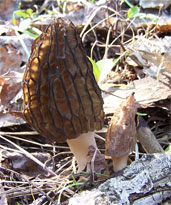
There are two main reasons why growing morels is so difficult: mycorrhizal relationships and the formation of sclerotia. Now you may be thinking that I made these terms up just to sound smart, so let’s examine both in greater detail.
Mycorrhizal Fungi:
Simply put, mycorrhizae are mutualistic relationships between fungi and plant roots. Morels were once thought to be only saprotrophic, meaning the mycelium of the mushroom fed on dead or dying organic material. Mycologists now believe they are mycorrhizal, meaning they get nutrients from the roots of trees.
Why does this happen in nature? In a mycorrhizal relationship, everyone benefits. The fungus receives carbohydrates such as glucose that the plant produces. In turn, the plant gets to absorb much more water and nutrients from the soil due to the additional surface area of the mycelium.
So the mycelium essentially “extends” the plant’s reach. Like a glove of fungal fingers stretching out for more nutrients. This relationship is extremely common, with over 95% of plants (including trees) suspected to be in relationships with mycorrhizal fungi.
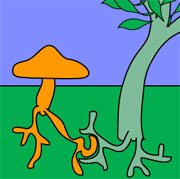
The picture to the left is a cute illustration of this process! It’s simple but you get the idea.
One can see how this makes certain mushrooms like morels much harder to grow. You can’t easily recreate or quickly force this relationship to happen. It’s not as simple as slapping spores on a petri dish or leaving a bale of straw outside with some spawn in it.
Despite this, morels aren’t believed to be exclusively mycorrhizal. They do seem to feed and be attracted to dead organic matter, mainly dead elm trees, like a true saprotroph. The extent to which method they use to feed is still, like so many concepts in mycology, not fully understood.
Sclerotia:
Growing morels is further complicated by the notion of sclerotia. No, that’s not something you have to be worried about catching from your date! It’s part of the morel life cycle that some other types of mushrooms don’t go through.
A sclerotium is a dense collection of hardened mycelium. This compacted mass is created to store nutrients during times when environmental conditions are less than ideal. It allows the organism to survive in a resting state when the weather is too dry or cold, mainly during the winter months.
When winter ends and conditions improve, these sclerotia either produce a mushroom or begin to grow new mycelium. Thus the problem becomes getting the sclerotia to produce actual mushrooms rather than just more mycelium. This doesn’t happen without temperature and water levels being just right.
Growing Morels: Better Your Odds
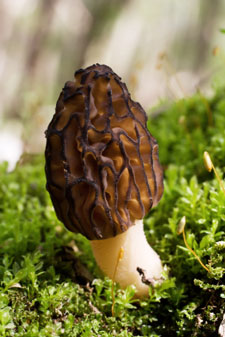
Now that we’ve seen why growing morels is so challenging, let’s look at some things you can do to increase your chances of success. While it’s not really feasible to create a mycorrhizal relationship or force sclerotia to produce mushrooms, there are some things you can do to mimic a true morel habitat.
Soil composition:
- Growing soil should be sandy without a lot of clay, rock, or gravel. The addition of some peat moss or gypsum may be helpful. You want it to be moist but still have good drainage.
Wood chips or mycorrhizal partners:
- Add wood chips on top of your grow site from a tree that morels are known to fruit near, such as ash or elm.
- You can also try planting your bed at the base of an elm tree, ash tree, or in an old apple orchard. The hope is that a mycorrhizal relationship may form, encouraging healthy morel production.
Water and temperature:
- Morels grow in areas where there is a distinct change from winter to spring. If you live in an environment with no real winter, your morel projects will probably be disappointing.
-
Don’t let your bed get too dry. It’s obviously unnecessary to water during the frigid winter months, but keep an eye that it doesn’t dry out too badly during other times of the year.
- Alternatively, you can contact a mad scientist and see if s/he has any old weather-controlling machines they’d be willing to sell. Be advised that this will no doubt be very expensive, and mad scientists often engage in long, boring stories about world domination.
Re-create a burn site:
- Create a small burn pile near your morel bed. Morels spring up after forest fires in nature, and burning organic material will simulate this.
- Mix some ashes from a burn pit into your soil when planting.
Of course, growing morels can be tricky and nothing is guaranteed. Remember that it can take a few years for a bed to produce mushrooms, so don’t be too disappointed if you don’t see anything the following spring. Or, at all.
Now that you understand the needs of these mushrooms a little better, why not try growing morels yourself? Click that link for step-by-step growing instructions!


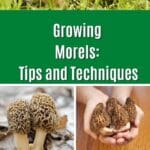

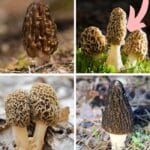
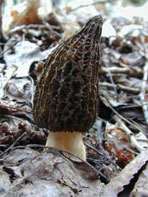
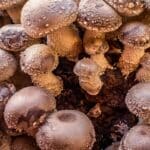
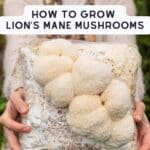
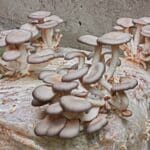
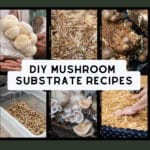
Art Dyck
Is there any danger to the home if I grow mushrooms in my house? For example, could the mushroom spores get into the wood framing of the house or in some other way grow into the house and damage the building?
Jenny
Yes, there is some danger of that, specifically with oyster mushrooms or other wood rot species. Morels won’t cause that problem though, if you even get them to sprout at all it’ll be a wonder! Spore dispersal is an issue and many people wear masks. If you’re just growing a few blocks, it’s not a major concern. But grow operations definitely have to think about it.